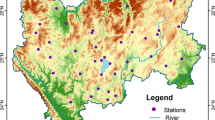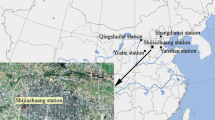Abstract
With the homogeneity-adjusted surface air temperature (SAT) data at 312 stations in eastern China for 1979-2008 and the Defense Meteorological Satellite Program/Operational Linescan System (DMSP/OLS) nighttime light data, the spatial heterogeneities of the SAT trends on different scales are detected with a spatial filtering (i.e. moving spatial anomaly) method, and the impact of urbanization in eastern China on surface warming is analyzed. Results show that the urbanization can induce a remarkable summer warming in Yangtze River Delta (YRD) city cluster region and a winter warming in Beijing-Tianjin-Hebei (BTH) city cluster region. The YRD warming in summer primarily results from the significant increasing of maximum temperature, with an estimated urban warming rate at 0.132–0.250°C per decade, accounting for 36%–68% of the total regional warming. The BTH warming in winter is primarily due to the remarkable increasing of minimum temperature, with an estimated urban warming rate at 0.102–0.214°C per decade, accounting for 12%–24% of the total regional warming. The temporal-spatial differences of urban warming effect may be attributed to the variation of regional climatic background and the change of anthropogenic heat release.
Article PDF
Similar content being viewed by others
Avoid common mistakes on your manuscript.
References
Intergovernmental Panel on Climate Change. IPCC AR4 Report. Cambridge: Cambridge University Press, 2007
Pielke R A. Land use and climate change. Science, 2005, 310: 1625–1626
Jiang D B, Zhang Y, Lang X M. Vegetation feedback under future global warming. Theor Appl Climatol, 2011, 106: 211–227
Li X, Yang X Q, Tang J P, et al. Multiple urban heat islands and surface energy balance during summer in Yangtze River Delta city cluster region simulated with WRF/NCAR (in Chinese). J Meteorol Sci, 2011, 31: 441–450
Kalnay E, Cai M. Impact of urbanization and land-use change on climate. Nature, 2003, 423: 528–531
Wang W C, Zeng Z, Karl T R. Urban heat islands in China. Geophys Res Lett, 1990, 17: 2377–2380
Jones P D, Groisman P Y, Coughlan M, et al. Assessment of urbanization effects in time series of surface air temperature over land. Nature, 1990, 347: 169–172
Zhao Z C. The changes of temperature and the effects of the urbanization in China in the last 39 years (in Chinese). Meteor Mon, 1991, 17: 14–17
Portman D A. Identifying and correcting urban bias in regional time series: Surface temperature in China’s northern plains. J Clim, 1993, 6: 2298–2308
Zhou S Z, Shu J. Urban Climatology (in Chinese). Beijing: Chinese Meteorological Press, 1994. 244–339
Easterling D R, Horton B, Jones P D, et al. Maximum and minimum temperature trends for the globe. Science, 1997, 277: 364–367
Zhou Y Q, Ren G Y. Identifying and correcting urban bias for regional surface air temperature series of north China over period of 1961–2000 (in Chinese). Climatic Environ Res, 2005, 10: 743–753
Fang F, Bai H Z, Zhao H Y, et al. The urbanization effect in northwestern China and its contribution to temperature warming (in Chinese). Plateau Meteorol, 2007, 26: 579–585
Ren G Y, Chu Z Y, Chen Z H, et al. Implications of temporal change in urban heat island intensity observed at Beijing and Wuhan stations. Geophys Res Lett, 2007, 34: L05711
Ren G Y, Zhou Y Q, Chu Z Y, et al. Urbanization effects on observed surface air temperature trends in North China. J Clim, 2008, 21: 1333–1348
Hua L J, Ma Z G, Guo W D. The impact of urbanization on air temperature across China. Theor Appl Climatol, 2008, 93: 179–194
Tang G L, Ren G Y, Zhou J X. Change of urban heat island intensity and its effect on surface mean air temperature records in southwest China (in Chinese). J Appl Meteor Sci, 2008, 17: 722–730
Hansen J, Ruedy R, Sato M, et al. A closer look at United States and global surface temperature change. J Geophys Res, 2001, 106: 23947–23963
Peterson T C. Assessment of urban versus rural in situ surface temperatures in the contiguous United States: No difference found. J Clim, 2003, 16: 2941–2959
Du Y, Xie Z Q, Zeng Y, et al. Impact of urban expansion on regional temperature change in the Yangtze River Delta. J Geogr Sci, 2007, 17: 387–398
He J F, Liu J Y, Zhuang D F, et al. Assessing the effect of land use/ land cover change on the change of urban heat island intensity. Theor Appl Climatol, 2007, 90: 217–226
Yang X C, Hou Y L, Chen B D. Observed surface warming induced by urbanization in east China. J Geophys Res, 2011, 116: D14113
Wang F, Ge Q S. Estimation of urbanization bias in observed surface temperature change in China from 1980 to 2009 using satellite land-use data. Chin Sci Bull, 2012, 57: 1708–1715
Chu Z Y, Ren G Y. Effect of enhanced urban heat island magnitude on average surface air temperature series in Beijing region (in Chinese). Acta Meteorol Sin, 2005, 63: 534–540
Kim M K, Kim S. Quantitative estimates of warming by urbanization in South Korea over the past 55 years (1954–2008). Atmos Environ, 2011, 45: 5778–5783
Li Q, Zhang H, Liu X, et al. Urban heat island effect on annual mean temperature during the last 50 years in China. Theor Appl Climatol, 2004, 79: 165–174
Li Q X, Li W, Si P, et al. Assessment of surface air warming in northeast China, with emphasis on the impacts of urbanization. Theor Appl Climatol, 2010, 99: 469–478
Zhang A Y, Ren G Y, Zhou J X, et al. On the urbanization effect on surface air temperature trends over China (in Chinese). Acta Meteorol Sin, 2010, 68: 957–966
Zhou L M, Dickinson R E, Tian Y H, et al. Evidence for a significant urbanization effect on climate in China. Proc Natl Acad Sci USA, 2004, 101: 9540–9544
Zhang J Y, Dong W J, Wu L Y, et al. Impact of land use changes on surface warming in China. Adv Atmos Sci, 2005, 22: 343–348
Lim Y K, Cai M, Kalnay E, et al. Observational evidence of sensitivity of surface climate changes to land types and urbanization. Geophys Res Lett, 2005, 32: L2271222
Nuñez M N, Ciapessoni H H, Rolla A, et al. Impact of land use and precipitation changes on surface temperature trends in Argentina. J Geophys Res, 2008, 113: D06111
Yang X C, Zhang Y L, Liu L S, et al. Sensitivity of surface air temperature change to land use/cover types in China. Sci China Ser D: Earth Sci, 2009, 52: 1207–1215
Fall S, Niyogi D, Gluhovsky A, et al. Impacts of land use land cover on temperature trends over the continental United States: Assessment using the North American Regional Reanalysis. Int J Climatol, 2010, 30: 1980–1993
Hu Y C, Dong W J, He Y. Impact of land surface forcings on mean and extreme temperature in eastern China. J Geophys Res, 2010, 115: D19117
Sun M, Tang J P, Xu C Y. Impact of urbanization and land-use change on regional temperature in eastern China (in Chinese). J Nanjing Univ Nat Sci, 2011, 47: 679–691
Trenberth K E. Climatology (communication arising): Rural land-use change and climate. Nature, 2004, 427: 213
Vose R S, Karl T R, Easterling D R, et al. Climate (communication arising): Impact of land-use change on climate. Nature, 2004, 427: 213–214
Zhang L, Yang X Q, Tang J P, et al. Simulation of urban heat island effect and its impact on atmospheric boundary layer structure over Yangtze River Delta region in summer (in Chinese). J Meteorol Sci, 2011, 31: 431–440
Ding Y H, Dai X S. Temperature change during the recent 100 years over China (in Chinese). Meteorol Mon, 1994, 20: 19–26
Li Q X, Liu X N, Zhang H Z, et al. Detecting and adjusting temporal inhomogeneity in Chinese mean surface air temperature data. Adv Atmos Sci, 2004, 21: 260–268
Li Q X, Dong W J. Detection and adjustment of undocumented discontinuities in Chinese temperature series using a composite approach. Adv Atmos Sci, 2009, 26: 143–153
Li Z, Yan Z W. Homogenized daily mean/maximum/minimum temperature series for China from 1960-2008. Atmos Oceanic Sci Lett, 2009, 2: 236–242
Li Z, Yan Z W. Application of multiple analysis of series for homogenization to Beijing daily temperature series (1960–2006). Adv Atmos Sci, 2010, 27: 777–787
Wu Z X. Preliminary analysis of the information on meteorological station historical evolution and its impacts on homogeneity of observational records (in Chinese). J Appl Meteorol Sci, 2005, 16: 461–467
Li Q X, Liu X N, Zhang H Z, et al. Homogeneity study of in situ observational climate series (in Chinese). Meteorol Sci Technol, 2003, 31: 3–10
Wu L H, Kang L L, Chen H Y, et al. Effect of meteorological observation environment variability on homogeneity of temperature series in Zhejiang Province (in Chinese). Meteorol Sci Technol, 2007, 35: 152–156
Cao L J, Yan Z W. Progresses in research of homogenization of climate data (in Chinese). Adv Clim Change Res, 2011, 7: 129–135
He C Y, Shi P J, Li J G, et al. Restoring urbanization process in China in the 1990s by using non-radiance-calibrated DMSP/OLS nighttime light imagery and statistical data. Chin Sci Bull, 2006, 51: 1614–1620
Wang H R, Zheng X Q, Yuan T. Overview of researches based on DMSP/OLS nighttime light data (in Chinese). Progr Geogr, 2012, 31: 11–19
He C Y, Li J G, Chen J, et al. The urbanization model and process in Bohai sea surrounding area in the 1990s by using DMSP/OLS data (in Chinese). Acta Geogr Sin, 2005, 60: 409–417
Shu S, Yu B L, Wu J P, et al. Methods for deriving urban built-up area using night-light data: Assessment and application (in Chinese). Remote Sens Technol Appl, 2011, 26: 169–176
Xu M J, Chen L, Liu H J, et al. Pattern and process of urbanization in the Yangtze Delta based on DMSP/OLS data (in Chinese). Remote Sens Land Resour, 2011, 3: 106–112
Ding Y H, Ren G Y, Zhao Z C, et al. Detection, causes and projection of climate change over China: An overview of recent progress. Adv Atmos Sci, 2007, 24: 954–971
Chen B, Shi G Y, Dai T, et al. Climate forcing due to anthropogenic heat release over China (in Chinese). Clim Environ Res, 2011, 16: 717–722
Zhang C, Shu J, Chen S S. Urban anthropogenic heat categorizing and its effects on urban temperature (in Chinese). Resour Environ Yangtze Basin, 2011, 20: 232–238
Zhang Y, Bao W J, Yu Q, et al. Study on seasonal variations of the urban-heat island and its interannual changes in a typical Chinese megacity (in Chinese). Chin J Geophys, 2012, 55: 1121–1128
Hua L J. An analysis of the temperature range and the warming effect of urbanization in China regions (in Chinese). Dissertation for the Doctoral Degree. Qingdao: Ocean University of China, 2004. 22–43
Ji C P, Liu W D, Xuan C Y. Impact of urban growth on the heat island in Beijing (in Chinese). Chin J Geophys, 2006, 49: 69–77
Zhang J H, Meng Q W, Li X, et al. Urban heat island variations in Beijing region in multi spatial and temporal scales (in Chinese). Sci Geogr Sin, 2011, 31: 1349–1354
Author information
Authors and Affiliations
Corresponding author
Additional information
This article is published with open access at Springerlink.com
Rights and permissions
This article is published under an open access license. Please check the 'Copyright Information' section either on this page or in the PDF for details of this license and what re-use is permitted. If your intended use exceeds what is permitted by the license or if you are unable to locate the licence and re-use information, please contact the Rights and Permissions team.
About this article
Cite this article
Wu, K., Yang, X. Urbanization and heterogeneous surface warming in eastern China. Chin. Sci. Bull. 58, 1363–1373 (2013). https://doi.org/10.1007/s11434-012-5627-8
Received:
Accepted:
Published:
Issue Date:
DOI: https://doi.org/10.1007/s11434-012-5627-8




